A frequently asked question on boating forums, mainly from first time buyers is: “Should I buy the cheaper boat and “do it up,” or buy one that’s in better condition, but more expensive?” Replies usually start, “It all depends on your skill levels, the condition of the boat, your personal circumstances and your budget.” In examining this question definitions should first be clarified, because boating metaphors often mean different things to different people.
THE PROJECT BOAT. (PB).
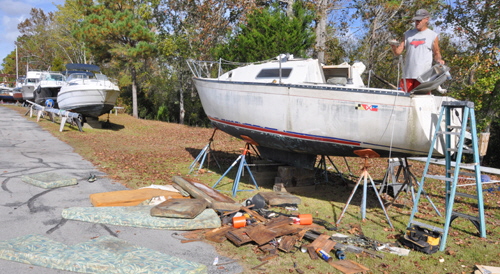 A project boat (PB) will be a vessel that has been neglected and needs a lot of work to restore it. For the right person who is capable of doing restoration work a PB can eventually result in a nice boat, that is quite a lot more valuable than the restorer paid. Also, if a person has a small budget a project boat may be the only way he can acquire a particular model. It can be a sound strategy provided the restorer has the time and ability to undertake the various jobs. It can also be particularly appealing if the boat can still be used during the restoration, so that some pleasure can be had while the work progresses. PB’s come in all shapes and sizes and are not necessarily older boats either, because many newer boat are not built ”like they used to be” and can deteriorate quickly if left uncared for.
A project boat (PB) will be a vessel that has been neglected and needs a lot of work to restore it. For the right person who is capable of doing restoration work a PB can eventually result in a nice boat, that is quite a lot more valuable than the restorer paid. Also, if a person has a small budget a project boat may be the only way he can acquire a particular model. It can be a sound strategy provided the restorer has the time and ability to undertake the various jobs. It can also be particularly appealing if the boat can still be used during the restoration, so that some pleasure can be had while the work progresses. PB’s come in all shapes and sizes and are not necessarily older boats either, because many newer boat are not built ”like they used to be” and can deteriorate quickly if left uncared for.
There are many reasons why a boat will decline into a PB. Financial factors of the owner usually plays a large part, or an owner may become ill or elderly and be unable to physically attend to his boat. Once a decision is made to sell a boat the incentive to maintain it often declines and it can quickly deteriorate. Project boats can be found in marinas everywhere and are like abandoned puppies begging for a new owner to take care of them. Boats like these two pictured above can often be had for no money because a marina might want them out of the way. A person could trailer one away or pay to keep it on the hard while repairing it.
THE READY-TO-GO BOAT. (RTGB).
Buying a ready to go boat (RTGB) is usually predicated by a buyers budget, and what he wants to do with the vessel. If he wants to immediately use it he will be more likely to consider a RTGB. Also, if he lacks the skills or the time to repair a PB, a RTGB will be a better choice. However, they are always more expensive than a PB because they are better kept. But it should also be remembered that a RTGB will likely not be entirely free of faults either, and there may be things that need doing that require the same skills as for a project boat, but usually to a lesser degree.
BUDGET.
It is often said that a project boat can be a “White elephant” because the cost of restoration may finish up exceeding the cost of a ready to go boat, mainly due to increases in the costs of materials and labor. A buyer of a PB will usually be able to buy a bigger vessel for his budget than a RTGB version, and may then be able to finance the restoration from work income.
EXPERIENCE.
A buyer may have a particular make and model in mind and it then becomes a question of the cost of model A, that has been well looked after, relative to model B that has been neglected, and consequently less expensive. Newcomers often look at project versions of a boat through rose-colored-glasses, and their lack of experience makes it difficult to accurately assess the costs associated with restoring a project boat. A well used rule-of-thumb states that any estimate should be doubled in both costs and time, but this will often go unheeded by an eager PB buyer. Unfortunately this is why project boats are frequently seen “For sale by owner,” by people who, for one reason or another, have found it impossible to continue with a PB. The vessel then transfers to another enthusiastic buyer, and sometimes even a third. It is therefore important for a prospective buyer of a PB to honestly assess whether he can (a) actually do the work and (b) enjoy doing it, because if there is little enjoyment the project will quickly sour, resulting in yet another “For sale by owner.” On the other hand, a skilled and experienced project boat restorer can “flip” a boat he has restored, and even make a profit
SURVEY.
An inspection by a professional marine surveyor will be highly advisable to any first time boat buyer, and a survey is normally required by insurers anyway. A good surveyor will be able to assess the cost of restoration of a PB to any level, either to be undertaken by the buyer himself or by a boatyard - and there will be a very, very, big difference between the two. Much can be learned about the condition of any boat by a careful inspection by a buyer himself, and many areas of neglect will be obvious even to a novice. Upon receipt of a survey a PB buyer should then make an honest assessment of his abilities and limitations to actually undertake the project, regarding time, skills and finances. It should also be remembered that boat surveyors are far from infallible, and there will probably be things that a surveyor misses on any type of boat.
AGE.
The age of a boat, along with the age of the buyer may determine what type of vessel will be best for a particular person. A young man might consider that he has plenty of time to restore a PB, before he even thinks about sailing it anywhere. An older person, perhaps recently retired will have a different perspective and may opt to buy a RTGB that requires little or no repair, and that can be enjoyed immediately with the minimum of attention.
SKILLS.
The skills and abilities needed to restore a PB are often underestimated by newcomers to boat ownership. A project boat that a buyer plans to largely restore himself might require the ability to repair or replace complicated electrical equipment, plumbing, carpentry, hydraulics, sails and ropes and the many sub-branches of these. It is perfectly possible to learn how to do individual tasks on a boat from specialist nautical books, Internet forums and suppliers' help lines, but even with the information about how to do something, it often requires skill and tools to actually do it.
Especially taxing on an old PB can be electrical repairs, because there may not be any wiring diagrams available and the wires will likely be brittle with insulation cracked or chaffed. The wiring system on an old PB may need completely replacing, which is both a tedious and expensive job. Even an experienced person sometimes needs to call in a specialist for certain jobs, especially if special instruments or gauges are needed, like in air conditioning systems diagnosis. Apart from skill, knowing where to buy materials at the right price is also an important part of the PB equation. The prospective buyer of a neglected boat should very seriously and honestly consider whether he can tackle these, because employing even unskilled assistants can greatly increase costs.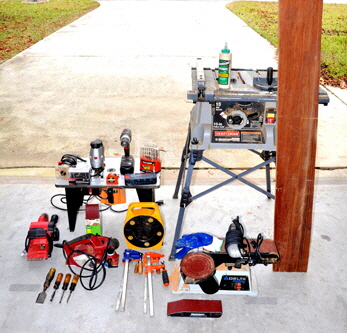
 TOOLS.
TOOLS.
Even if the new owner of a project boat has the skills, repairs frequently require a large collection of different tools, especially for carpentry work. I recently repaired a damaged toe-rail on Britannia. It required shaping and splicing in a new 6’ foot long teak plank, 7” inches wide and 1” inch thick that I bought wholesale for $130, and what I considered to be a good price. The tools that were employed for the repair were: a bench circular saw, an electric hand sander, a bench sander, a jig-saw, an oscillating sander, a hand router, a power planer, a power drill, four clamps, four different chisels, along with numerous screws, glues, caulking and varnish. If a person has to buy or rent some of these tools costs will rise. I already had them all except the wood, so the actual cost of the repair was only $130. This was a bit different to a quote from a local carpentry shop for the same job of between $600 and $800. During the course of Britannia’s restoration there have been numerous similar instances of savings amounting to thousands. Another advantage for an owner doing repairs himself is that he gets to know his boat intimately, that one day might be a life saver at sea.
PERSONAL CIRCUMSTANCES.
Whether to buy a project or ready to go boat can also depend very much upon the personal circumstances of the buyer. Spouses often have input as to the type of boat being considered, and especially the budget. A single person might not have these constraints and may even decide to live on the boat, thereby reducing costs in other directions, but a married buyer with children may not have these options. The latter would probably be better to consider a RTGB that can be enjoyed by all members of the family straight away, even if this stretches his initial budget. Repairs on any type of boat can take a lot of time, and if a couple are both inexperienced conflicts can occur.
A PERSONAL EXPERIENCE.
In 2010 I began searching for a specific model of a 50’ foot sailboat, with a budget of around $180,000, but I was unable to find a vessel to my liking. I then found a similar sized ketch on my doorstep, but I immediately saw that it was in the project boat realm. It was obvious that it suffered from a lack of maintenance, and many things did not work at all. I still paid for a professional survey to look at it, after which I bought the boat for less than half the asking price, and one quarter of my budget. As I began working on the boat I discovered things that the surveyor had overlooked, and for the first two years most of my time was spent repairing or replacing unusable equipment. The advantage of this was that I could choose the equipment I wanted, and I was able to install most of it myself.
I have been messing about with boats for over 50 years and consider myself to have above average skills in all the categories mentioned. I already had all the tools and was newly retired, so I had the time to work on the boat. It is also an advantage to have a wife who enjoys sailing and better still, varnishing. In fact we were ideal candidates to buy a project boat, but some of the alterations I made are well outside an average project boat buyer's experience or skill level. For example: 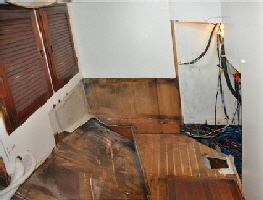
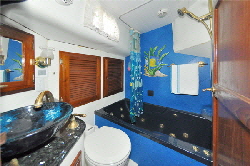 I changed the rig from a ketch to a schooner by moving the masts and standing rigging. I installed a squaresail on the foremast, then converted all the sails to roller furling to be operated from the safety of the center cockpit. I completely remodeled the three cabins and both bathrooms, I installed a full size hot-tub bath in the owner's aft en-suite bathroom. The galley was modernized to include a deep-freeze, a washer/dryer and microwave oven. I installed two electric toilets with waste treatment systems to do away with the smelly holding tank. I fitted two air conditioning units and upgraded all the plumbing and i
I changed the rig from a ketch to a schooner by moving the masts and standing rigging. I installed a squaresail on the foremast, then converted all the sails to roller furling to be operated from the safety of the center cockpit. I completely remodeled the three cabins and both bathrooms, I installed a full size hot-tub bath in the owner's aft en-suite bathroom. The galley was modernized to include a deep-freeze, a washer/dryer and microwave oven. I installed two electric toilets with waste treatment systems to do away with the smelly holding tank. I fitted two air conditioning units and upgraded all the plumbing and i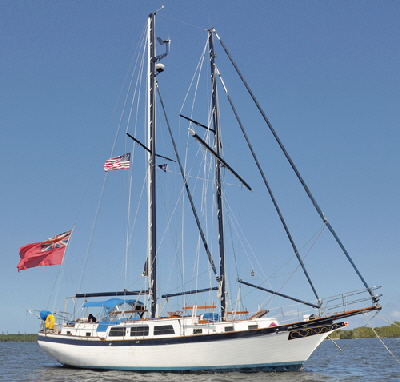 instrumentation. I bought a new 45 miles high definition color radar to replace the ancient defunct Decca unit. The cost of modifications and restoration over the years has been nearly $100,000, but even after adding the cost of buying the boat I have still spent less than my original budget, and I now have a fine ocean cruising boat exactly to my liking. These, along with many more innovations are detailed in the pages of this website.
instrumentation. I bought a new 45 miles high definition color radar to replace the ancient defunct Decca unit. The cost of modifications and restoration over the years has been nearly $100,000, but even after adding the cost of buying the boat I have still spent less than my original budget, and I now have a fine ocean cruising boat exactly to my liking. These, along with many more innovations are detailed in the pages of this website.
Of course, none of these alterations and additions includes my labor, (although it does include the costs of specialists for certain jobs), and if this was added the figure would be ridiculously higher. The accountant will no doubt say labor should be costed in, but my reply would be that I have mainly enjoyed the whole exercise, along with sailing the boat in between projects. So should I therefore not deduct the cost of the enjoyment, and at what rate? Now, twelve years later I own a very unique brigantine schooner that bears no resemblance whatsoever either inside or out, to the original project boat.
CONCLUSION.
In trying to answer the question first posed, so much depends upon the boat and the individual buyer. This article is therefore only an outline of possible eventualities, along with some pitfalls that may confront a would-be buyer of either type of boat. In the final analysis, “Caveat emptor” may be the best advice that anyone can be given.
